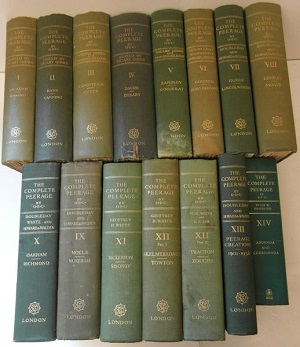Related Research Articles

Earl of Glasgow is a title in the Peerage of Scotland. It was created in 1703 for David Boyle, Lord Boyle.
The title of Earl of Blessington was created twice in the Peerage of Ireland, in 1745 and 1816. Both creations became extinct, in 1769 and 1829 respectively. The earldom was also spelt as Blesington.
Gilbert Fitz Richard, 2nd feudal baron of Clare in Suffolk, and styled "de Tonbridge", was a powerful Anglo-Norman baron who was granted the Lordship of Cardigan, in Wales c. 1107–1111.

Henry Scott, 3rd Duke of Buccleuch and 5th Duke of Queensberry KG FRSE was a Scottish nobleman and long-time friend of Sir Walter Scott. He is the paternal 3rd great-grandfather of Princess Alice, Duchess of Gloucester, and the maternal 4th great-grandfather of Prince William of Gloucester and Prince Richard, Duke of Gloucester.

The Complete Peerage ; first edition by George Edward Cokayne, Clarenceux King of Arms; 2nd edition revised by Vicary Gibbs et al.) is a comprehensive work on the titled aristocracy of the British Isles.

David Boyle, 1st Earl of Glasgow was a Scottish politician and peer. He was the last Treasurer-depute before the Union with England.
George Hamilton, 3rd Earl of Abercorn died unmarried in Padua on a voyage to Rome. He was succeeded by Claud Hamilton, heir of Claud Hamilton, 2nd Baron Hamilton of Strabane, second son of the 1st Earl of Abercorn.
James Hamilton, Lord Paisley was the eldest son of James Hamilton, 2nd Earl of Abercorn and Katherine Clifton, 2nd Baroness Clifton. Born a Catholic he became a Presbyterian before 1646. He predeceased his father and is therefore an example of an heir apparent who never succeeded.

Edward Brooke, 6th Baron Cobham, lord of the Manor of Cobham, Kent, was an English peer.
Events from the year 1607 in Ireland.
Margaret de Audley,suo jure2nd Baroness Audley and Countess of Stafford was an English noblewoman. She was the only daughter of Hugh de Audley, 1st Earl of Gloucester, by his wife Lady Margaret de Clare. Her mother was the daughter of Joan of Acre, Princess of England; thus making Margaret a great-granddaughter of King Edward I by his first consort, Eleanor of Castile. As the only daughter and heiress of her father, she succeeded to the title of 2nd Baroness Audley [E., 1317] on 10 November 1347.

Susan Feilding, Countess of Denbigh, was an English courtier. She was First Lady of the Bedchamber to Queen Henrietta Maria from 1626 until her death in 1652.
Robert de Ferrers, 3rd Baron Ferrers of Chartley, was the son of John de Ferrers, 1st Baron Ferrers of Chartley and Hawise de Muscegros, a daughter of Robert de Muscegros.
The title of Lord Ross was a Lordship of Parliament in the Peerage of Scotland. It was created in 1499 for Sir John Ross, of Halkhead.
Sir Henry Knollys of Kingsbury, Warwickshire was an English courtier, privateer and Member of Parliament.
The Custos Rotulorum of Meath was the highest civil officer in County Meath. The position was later combined with that of Lord Lieutenant of Meath.
Elizabeth Annesley, Countess of Anglesey was the wife of Arthur Annesley, 1st Earl of Anglesey. They were married on 24 April 1638 in London. At the time of their marriage, her husband's style was The Hon. Arthur Annesley. In 1660 he inherited his father's title of Viscount Valentia, making Elizabeth a viscountess, and in the following year he was created Earl of Anglesey, making her a countess.

Elizabeth Scott, Duchess of Buccleuch, formerly Lady Elizabeth Montagu, was the wife of Henry Scott, 3rd Duke of Buccleuch.
Anne Lennox, Duchess of Richmond, formerly Anne Brudenell, was the wife of two English noblemen: first, Henry Belasyse, 2nd Baron Belasyse of Worlaby, and second, Charles Lennox, 1st Duke of Richmond. She was the mother of Charles Lennox, 2nd Duke of Richmond.
Frances Hales, later Countess of Lichfield, was an English aristocrat and philanthropist.
References
- ↑ List of railway station names in English, Scots and Gaelic – NewsNetScotland
- ↑ OS 25 inch Scotland, 1892-1905, Explore georeferenced maps (National Library of Scotland)
- ↑ Paisley, Hawkhead House, Canmore
- ↑ Paisley Mansions: Hawkhead, Paisley.org
- ↑ Hawkhead House Farm, Farmhouse, British Listed Buildings
- ↑ Millionaire scrap dealer chased for more than £64,000 for trading without licence, Daily Record, 21 October 2015
- ↑ Farmer fined over neglect of bull, BBC News, 21 August 2009
- ↑ Sir James Balfour Paul, The Scots Peerage, Volume VII
- ↑ Cokayne, George E.; Vicary Gibbs, Peter; Doubleday, Harry; Howard de Walden, Lord David (1958). The Complete Peerage of England, Scotland and Ireland, Great Britain and Northern Ireland, extant, abeyant, dormant and extinct. XIV vols.
- ↑ "Hawkhead Hospital". Historic Hospitals. 26 April 2015. Retrieved 4 February 2020.